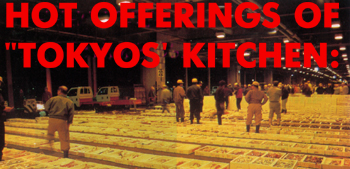 |
REGIONAL INFORMATION DIGESTECONOMY, ECOLOGY, HISTORY, CULTURE |
# 2, 1997

Tom WRAY
PROCESSING and
packaging fish for export to Japan--the great Mecca of
fisheries--has become a major activity for many of the world's
seafood producers. Much of their supplies pass through Tsukiji
Market, the "kitchen of Tokyo", which sells fish worth
$22 to $23 million a day. Importing, sorting and stocking these
fish and shellfish--then selling them to middlemen and others –
is the main business of wholesale traders such as Daito Gyorui
Co. Ltd.
Daito--which in
1994 handled 206,131 tons of fish Importing, sorting and stocking
these fish and shell-fish--then selling them to middlemen and
others--is the main business of whole-sale traders such as Daito
Gyorui Co. Ltd.
TOKYO's bustling Tsukiji central wholesale market, which is open
24 hours a day, usually begins to receive fish at around
midnight.
Inspections, made at about 4 am before the first auction, are an
important part of the wholesaler's work, Yutaka Numi, deputy
manager of Daito Gyorui's international department, tells FNI.
"We check for quantity and quality, and start thinking about
the day's prices," he says.
The first
auction starts at about 5.30 am and takes some 30 minutes. The
1000 middle whole-salers (jobbers) take the fish they have bought
to their own shops in the market and lay them out for sale to
retailers, caterers and others. Meanwhile, other fish bought at
the auction goes to supermarkets and for market distribution. The
last fish auction of the day at Tsukiji is usually completed
between 8 and 9 am. After that, Daito contacts buyers at local
markets and delivers fish. The company's work is usually finished
by about 1 or 2 pm. "Tsukiji market handles about 2500
tonnes of fish, worth US$22 to 23 million, a day," according
to Yutaka Niimi.
"Roughly one-third of the fish is fresh, one-third is frozen
and one-third dried or in other forms."
There are seven market wholesalers, five of which handle all
kinds offish, and two specialising in dried and salted products.
Four whole-salers are large.
Around 18,000
people work at the market, which attracts about 30,000 buyers,
according to Yutaka Nilmi. Around 48,000 people may be packed
into the 225,126 sq. metre market each morning!
On a recent visit to the market, FNI technical editor Tom Wray
saw fresh and frozen tunas from many countries, including
purse-seine caught and pen-reared southern bluefin from
Australia. Fresh sashimi grade tuna was earning up to 8000 yen
per kg at auction.
There are,
however, other costs. On fish air-freighted into Japan, these
include import tax (about 4.7 per cent), consumption tax (three
per cent), customs expenses and transport from Narita
International Airport to Tsukiji. So, deductions are about--15
per cent of the auction price. "Usually, with a new sup
plier, we ask him to send a small trial shipment of fish after
initial talks," says Yutaka Niimi.